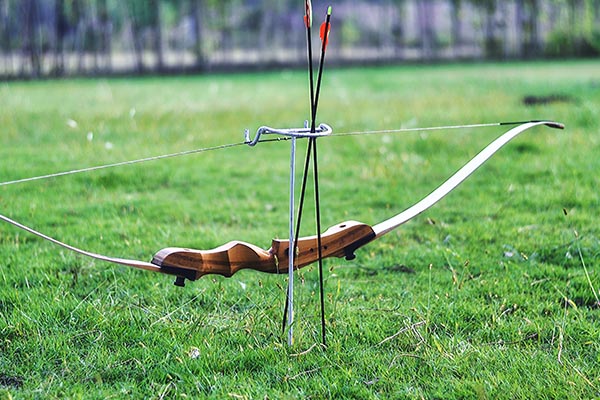The bow and arrow have been utilized by hunters and warriors for thousands of years. A simple-yet-elegant weapon, it’s provided meat and aided in defending civilizations for centuries. Today, bows have gone high-tech. But we shouldn’t neglect the standard bows and arrows of our ancestors. They can provide us with a bounty of wild game or defense from predators in a primitive survival situation.
How To Make The Bow
Step 1
Choose wood wisely. The base for any good bow is choosing the right wood. You’ll want to use hard forestland similar to hickory, oak, and maple. Avoid weaker forestland similar to pine since you’d need to use thicker pieces – adding weight and redundant bulk – to avoid breakage. Look for a periphery of at least eight inches, which will bear a lower figure. Because curvatures are made from perpendicular slices of the tree, on a lower tree the bow of the outside edge – the part that becomes the reverse of your bow – will be more pronounced, taking further paring to flatten it out.
Step 2
Cut and resolve the tree. An 8-inch tree provides six or seven bow staves. Leave enough room on the end of each stave to cut off roughly 6 inches, where the wood might have cracks. For illustration, a 68-inch bow needs at least a 6-bottom piece of wood. Keep the stave roughly 1 inch wide from tip to tip and 1 inch thick. Leave the dinghy on to reduce cracking as the wood dries.
Step 3
Let the wood dry. This generally takes at least three or four weeks but can be over a year. However, buy a humidity cadence and stay for a readout of 11 or 12 percent, if you want to be sure. The most flexible wood will underpin into a bend called a kickback.
Step 4
Disembark your bow with a draw knife, as shown below, and mark the shape of the bow’s spate. For a Native American longbow, the 5 inches in the center should be narrower than the branches – 1 ¼ inch across, widening out to about 1 ½ inch.
Step 5
With a drawknife or band saw, upgrade the shape. Use a political cutter to finish the effects off.

Step 6
Lay the bow flat and taper the sides of the branches with a drawknife. The middle 5 inches, which will be your grip, should be ¾ inch thick, tapering off to 1/2 inch when you reach the ends.
Step 7
Use a chainsaw train, as seen below, to make string grooves at a 45-degree angle on the outside of both tips, about 1/2 an inch from each end. On the bottom branch, make a redundant set of grooves for the bow stringer, a separate string used to bend the bow for threading.
Step 8
Beach down the edges and tips and smooth the front and back shells. Also, with one tip of the bow against the ground, apply pressure to the top to produce a slight bend; this is called bottom tillering – examining the bow for any cracks or imperfections. However, you’ll have to start over with a new piece of wood, if you see anything other than small cracks on the front.
Step 9
produce a cultivator tree( below) to test your bow’s inflexibility. Vertically secure a 2 x 4 to the wall. Starting 5 inch from the top, make a vertical notch with a Skilsaw every inch until you reach 30 inch. String the bow approximately with a parachute cord, center it on the top of the tree, and sluggishly move the string down the notches until it reaches the 28-inch mark, a typical full draw. At each step look for unevenness in the bend of the limbs. However, indeed they end up by pairing from the side that doesn’t bend as much, if they don’t bend inversely.
Step 10
dock the parachute cord to make a small bend in the bow( 5 inch between the bow center and the string). constantly draw the bow in a glass to see which side remains slightly stiffer. The stiffer branch will be your lower branch. Once you identify it, use a sander to produce a shallow indentation above the handle to the right or left, depending on which hand you use to shoot the arrow.
Step 11
Beach and finish the bow. nimrods may want to use a dark stain because it’s harder for creatures to see.
Step 12
Once the bow has been stained, dried, and sealed, wrap the 5 inch of the handle with hemp cord using a trouncing fashion( below). Apply a light fleece of cement, similar to Titebond III, and let dry.
Step 13
produce your final bowstring using a new length of B-50 bowstring material. A duly threaded longbow should have enough bend to leave roughly 7 inches between the bow and the string.
How To Make The Arrows
Step 1
Shaft diameter is determined by the weight of your bow and other factors. Consult a chine map to find the applicable periphery, and also order a set of matched rustic shafts. Paul Jalon of Elite Arrows in Bloomfield Hills, Michigan, has drafted his own arrows – been used to win 24 International Bowhunting Organization World Championships – since 1952. Jalon prefers to use Port Orford cedar, but Sitka improves,s and Douglas fir work too.
Step 2
Wipe the shafts down with acetone to remove any tire. also, smoothly beach them.
Step 3
Use the taper tool, which resembles a large pencil sharpener, to taper one end of the shaft to fit your slot. Taper tools make both 5-and 11-degree tapers. Use the 11-degree taper for the slot.
Step 4
Roll the shaft in an arrow incentive to find any bends.( You can make a simple interpretation yourself using four casters.) Treat any angles by holding the arrow forcefully on a flat face and running the body of a screwdriver over it from end to end.
Step 5
Seal your shafts by brushing them with an acrylic bottom finish. Let them dry for three to four hours, and also beach smoothly. reprise for three total fleeces.
Step 6
Use clear fletching cement or instant glue to attach a slot to the phased end of the shaft. also use a fletching ploy to attach three or four pre cut feathers, and let dry.
Step 7
Place the uncut arrow on your bow and draw it back. Have someone differently mark the arrow an inch in front of the bow handle. Cut the arrow at the mark, taper the cut end, and apply your point or broadhead using hot cement or epoxy resin. Let dry.

